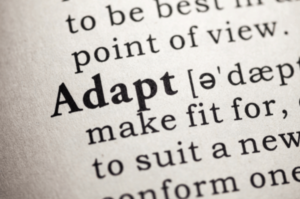Developing Adaptability In The Workplace by Monique Daigneault
Posted On 05/24/2021 By admin
ONE OF THE EXPECTATIONS FOR LEADERS IS THAT THEY BECOME HIGHLY ADAPTABLE TO THE FAST-PACED ENVIRONMENTS IN WHICH THEY WORK.

They need to pivot quickly whenever a change occurs yet to do so in a calm and centered way while still focusing on corporate goals, team morale, and project execution. That is not an easy feat at all! This is made even more difficult when there is a natural psychological cycle that each person goes through when they are faced with change.
In many circumstances, workplace change can be likened to the grief cycle that was first introduced by Elisabeth Kubler-Ross. Ms. Kubler-Ross identified five different stages of grief: denial, anger, bargaining, depression, and acceptance. The denial phase usually begins with shock or a refusal to accept reality. Initially, denial is necessary because it protects us from being overwhelmed. It consists of avoidance, confusion, shock, or fear.
Anger comes with frustration and anxiety. Bargaining is a way to find meaning by reaching out to others or telling one’s story. Depression can manifest itself as overwhelm, hostility, or flight. Acceptance is a period of exploration, putting a new plan in place, and moving on. Do you see anything in this description that reminds you of a past or current workplace change?
Although people move through these stages at different rates, doing so helps them accept and even thrive during and after workplace change.
HOW CAN LEADERS DEVELOP THE ADAPTABILITY THEY NEED TO MANAGE MULTIPLE CHANGE EVENTS AT ANY GIVEN TIME, WHILE ALSO GUIDING THEIR TEAM?
If you are a leader, you need to realize that before you can lead others through change, you must first prepare yourself to manage change. Here are some ways you can do that:
· Proactively stay abreast of industry best practices regarding change management.
· Understand the five stages of the grief cycle and which phase you are in at any given time during a change event.
· Gather as much information as you can about the impending change, realizing that more information will unfold over time.
· Analyze the big picture so that you understand why the change is necessary and its benefits to the organization or department. This does not mean you have to agree with it, but you at least need to see it from a strategic view.
· Offer to assist with any pieces of the change initiative. The more you help, the more in control you will feel, and the more information you will be privy to as it unfolds.
· Take care of yourself during the change process and continue to hone your leadership skills.
· Create your own individual change model so that you have a personalized process to follow when you are faced with change and need to adapt quickly. This would involve steps you take, behaviors you embody, or people you rally for support.
BECOMING ADAPTABLE AND LEARNING TO MANAGE CHANGE TAKES A DELIBERATE EFFORT ON YOUR PART.
Once you have done this individual work, you will be better prepared to lead others through change. In the second blog this month, I will provide more information on how you can support your team and others when they are faced with workplace change.
Tags: adaptable, change, expectation, grief cycle, pivot, workplace
Author: Monique Daigneault
Original post: https://mdconsultingglobal.com/developing-adaptability-in-the-workplace/







